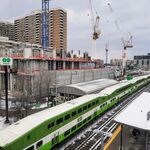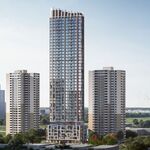Midtown Urbanist
Superstar
Peering through the Lower Don Lands / Portlands EA that got released earlier in the week, I can see now why they are projecting high ridership on Waterfront East LRT.
Villiers Island alone is expected to have between 8,200 to 10,700 people whose only transit access really will be the Cherry Streetcar. (For reference, the entire West Don Lands is supposed to house merely 6,000 people upon completion.)

Acording to the EA, the East Bayfront district is looking at 6,000 Residential Units (using Villiers Island math; that comes to between 10,080 and 13,200 people) and 8,000 jobs.
The Keating Channel District (north side of Keatin Channel), is projecting 4,000 Residential Units (6,720 to 8,800 people).
The Polson Quay & South River District (south of Villiers Island) is projected 4,500 people.
The Film Studio District (east of Villiers Island; Cherry Streetcar to turn east on Commissioners into this district) is projected 9,225–13,350 people and 9,500–14,500 jobs.
-----
Added together, that is some 38,725 to 50,550 people along with 20,400 to 25,400 jobs (and this is not counting Lower Yonge and Jarvis precincts, and assuming East Harbour workers take other transit lines) that you got to pack on the streetcar/LRT line along Waterfront East/Cherry Street.
Evidently, these figures are projected for 2050 full-build out scenario, but the East Harbour and other sites along Queens Quay are going to be full of residents in the relatively near future already. We are creating plans for a community that relies on a single transit line to get anywhere, and is rather isolated otherwise. Seeing these numbers on the screen shows the importance of beginning to build transit ahead of time, lest we end with another Humber Bay Shores.
Villiers Island alone is expected to have between 8,200 to 10,700 people whose only transit access really will be the Cherry Streetcar. (For reference, the entire West Don Lands is supposed to house merely 6,000 people upon completion.)
Acording to the EA, the East Bayfront district is looking at 6,000 Residential Units (using Villiers Island math; that comes to between 10,080 and 13,200 people) and 8,000 jobs.
The Keating Channel District (north side of Keatin Channel), is projecting 4,000 Residential Units (6,720 to 8,800 people).
The Polson Quay & South River District (south of Villiers Island) is projected 4,500 people.
The Film Studio District (east of Villiers Island; Cherry Streetcar to turn east on Commissioners into this district) is projected 9,225–13,350 people and 9,500–14,500 jobs.
-----
Added together, that is some 38,725 to 50,550 people along with 20,400 to 25,400 jobs (and this is not counting Lower Yonge and Jarvis precincts, and assuming East Harbour workers take other transit lines) that you got to pack on the streetcar/LRT line along Waterfront East/Cherry Street.
Evidently, these figures are projected for 2050 full-build out scenario, but the East Harbour and other sites along Queens Quay are going to be full of residents in the relatively near future already. We are creating plans for a community that relies on a single transit line to get anywhere, and is rather isolated otherwise. Seeing these numbers on the screen shows the importance of beginning to build transit ahead of time, lest we end with another Humber Bay Shores.






